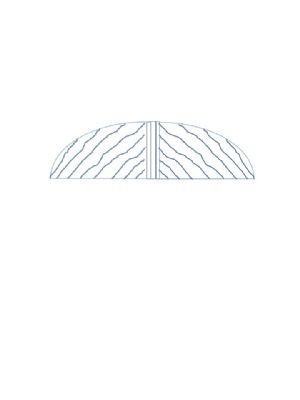
 |
|
#31
|
|||
|
|||
|
Quote:
Leo's first "electric Spanish guitars" had no trussrod. Which he ended up correcting pretty soon after. But he was an amp guy who designed a guitar that can be amplified without feedback. And that neck heel on the Strat, with its 5" radius end with 1/4" radius fillets on each corner, and 2-3/16" heel width (I memorized these because I've drawn them countless time in CAD), is the standard by which most all modern necks are based. So flawed or not, we love it... Heck, I'm a bit flawed myself, but my wife still loves me! |
|
#32
|
|||
|
|||
|
I think flat sawn wood gets a bad rap, because much of what is bought as lumber has a lot of grain runout. Quartersawn when cut well tends to have little runout.
One of the things that I find attractive about the multi-piece neck is that you can take a piece of rift sawn wood, cut it in half, flip it and end up with with mirror image grain that helps it resist twisting. (Like in the sketch) 
|
|
#33
|
|||
|
|||
|
Quote:
__________________
Fred |
|
#34
|
|||
|
|||
|
Quote:
__________________
Fred |
|
#35
|
|||
|
|||
|
Quote:
Then again if you were to make these guitars inexpensively, making them by hand seems to contradict that notion unless the goal is to give your services inexpensively, since there's some labor involved. And if take no regard to grain direction, that labor goes up significantly. Speaking of inexpensive, I purchased some very inexpensive semi-finished 14-fret neck blanks second-hand that Martin had sold as seconds for something like $20 each. The headplates are already laminated and the holes drilled. Volute and heel are carved, and the tenon is machined. They just need trussrod and fretboard. The 12-fret slot head necks cost me a bit more. But I got them for the same reason - to provide inexpensive alternatives. A semi-finished blank from the lutherie suppliers goes for something like $150-170. The blems on these are not bad at all, some would sand off, some to me are more "character" marks. |
|
#36
|
|||
|
|||
|
Quote:
Rift sawn has different meanings in certain places and groups of people . To some , rift sawn is a process and not a finished product . To others it is a finished product but not a process . To some , the finished product is truly quarter sawn but to others it is not . I raise this here and now because the post containing the drawing that you reference is that the OP calls it rift sawn and clearly does not imply quartersawn . At least , that is what the drawing indicates in context with the written portion . Of course , I may be misinterpreting the idea that the OP did not imply or mean quartersawn . |
|
#37
|
|||
|
|||
|
Fender necks would be better if they were true bolt on designs rather than the screws which wiggle loose and enlarge the holes. When you think about it, string tension wants to shove the neck into the back of the neck pockets so those screws have a shear force on them which acts out on the wood in the neck. Many times you have to fix screw holes because of that. Sometimes you can just harden them up with CA or fill them with a toothpick. Threaded inserts and true bolts would be better. BUt for the most part it still works.
|
|
#38
|
|||
|
|||
|
Quote:
|
|
#39
|
|||
|
|||
|
Quote:
|
|
#40
|
|||
|
|||
|
Quote:
|
|
#41
|
|||
|
|||
|
Quote:
Another alternative is the neck could be bottomed in the pocket to change the shear in the bolts to compression between the neck and pocket. Any of them will work.
__________________
Rodger Knox, PE 1917 Martin 0-28 1956 Gibson J-50 et al |
|
#42
|
|||
|
|||
|
Quote:

|
|
#43
|
|||
|
|||
|
Quote:
On occasion the lumberyard does get in other woods that is of good enough quality, like the African mahogany or the Spanish cedar. I was hoping to get a feel for other woods to work with, I have more than enough maple. I can see giving my time away as I will be retired and I do not need to supplement my income. I also do not want to step on the toes of the few luthiers that build in the area competing for the same customers. The people I expect to build for would likely not have a guitar hand built for themselves. I do want to build some instruments that approach the eye candy appeal of some of the guitars here but generally I want to make an affordable guitar for those who would appreciate it more.
__________________
Fred |
|
#44
|
|||
|
|||
|
Quote:
My experience tells me that even if the holes are oversized and the screws have room to move around, the neck doesn't move if they are tight enough.
__________________
Rodger Knox, PE 1917 Martin 0-28 1956 Gibson J-50 et al |
|
#45
|
|||
|
|||
|
Quote:
|